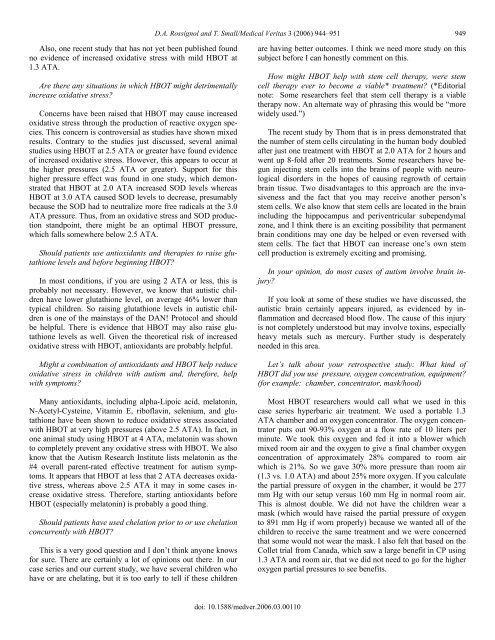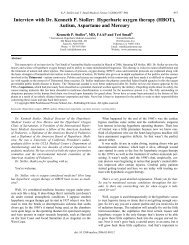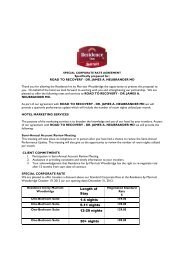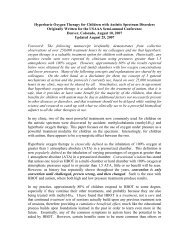Interview with Dr - Dr. Neubrander
Interview with Dr - Dr. Neubrander
Interview with Dr - Dr. Neubrander
Create successful ePaper yourself
Turn your PDF publications into a flip-book with our unique Google optimized e-Paper software.
D.A. Rossignol and T. Small/Medical Veritas 3 (2006) 944–951 949<br />
Also, one recent study that has not yet been published found<br />
no evidence of increased oxidative stress <strong>with</strong> mild HBOT at<br />
1.3 ATA.<br />
Are there any situations in which HBOT might detrimentally<br />
increase oxidative stress<br />
Concerns have been raised that HBOT may cause increased<br />
oxidative stress through the production of reactive oxygen species.<br />
This concern is controversial as studies have shown mixed<br />
results. Contrary to the studies just discussed, several animal<br />
studies using HBOT at 2.5 ATA or greater have found evidence<br />
of increased oxidative stress. However, this appears to occur at<br />
the higher pressures (2.5 ATA or greater). Support for this<br />
higher pressure effect was found in one study, which demonstrated<br />
that HBOT at 2.0 ATA increased SOD levels whereas<br />
HBOT at 3.0 ATA caused SOD levels to decrease, presumably<br />
because the SOD had to neutralize more free radicals at the 3.0<br />
ATA pressure. Thus, from an oxidative stress and SOD production<br />
standpoint, there might be an optimal HBOT pressure,<br />
which falls somewhere below 2.5 ATA.<br />
Should patients use antioxidants and therapies to raise glutathione<br />
levels and before beginning HBOT<br />
In most conditions, if you are using 2 ATA or less, this is<br />
probably not necessary. However, we know that autistic children<br />
have lower glutathione level, on average 46% lower than<br />
typical children. So raising glutathione levels in autistic children<br />
is one of the mainstays of the DAN! Protocol and should<br />
be helpful. There is evidence that HBOT may also raise glutathione<br />
levels as well. Given the theoretical risk of increased<br />
oxidative stress <strong>with</strong> HBOT, antioxidants are probably helpful.<br />
Might a combination of antioxidants and HBOT help reduce<br />
oxidative stress in children <strong>with</strong> autism and, therefore, help<br />
<strong>with</strong> symptoms<br />
Many antioxidants, including alpha-Lipoic acid, melatonin,<br />
N-Acetyl-Cysteine, Vitamin E, riboflavin, selenium, and glutathione<br />
have been shown to reduce oxidative stress associated<br />
<strong>with</strong> HBOT at very high pressures (above 2.5 ATA). In fact, in<br />
one animal study using HBOT at 4 ATA, melatonin was shown<br />
to completely prevent any oxidative stress <strong>with</strong> HBOT. We also<br />
know that the Autism Research Institute lists melatonin as the<br />
#4 overall parent-rated effective treatment for autism symptoms.<br />
It appears that HBOT at less that 2 ATA decreases oxidative<br />
stress, whereas above 2.5 ATA it may in some cases increase<br />
oxidative stress. Therefore, starting antioxidants before<br />
HBOT (especially melatonin) is probably a good thing.<br />
Should patients have used chelation prior to or use chelation<br />
concurrently <strong>with</strong> HBOT<br />
This is a very good question and I don’t think anyone knows<br />
for sure. There are certainly a lot of opinions out there. In our<br />
case series and our current study, we have several children who<br />
have or are chelating, but it is too early to tell if these children<br />
are having better outcomes. I think we need more study on this<br />
subject before I can honestly comment on this.<br />
How might HBOT help <strong>with</strong> stem cell therapy, were stem<br />
cell therapy ever to become a viable* treatment (*Editorial<br />
note: Some researchers feel that stem cell therapy is a viable<br />
therapy now. An alternate way of phrasing this would be “more<br />
widely used.”)<br />
The recent study by Thom that is in press demonstrated that<br />
the number of stem cells circulating in the human body doubled<br />
after just one treatment <strong>with</strong> HBOT at 2.0 ATA for 2 hours and<br />
went up 8-fold after 20 treatments. Some researchers have begun<br />
injecting stem cells into the brains of people <strong>with</strong> neurological<br />
disorders in the hopes of causing regrowth of certain<br />
brain tissue. Two disadvantages to this approach are the invasiveness<br />
and the fact that you may receive another person’s<br />
stem cells. We also know that stem cells are located in the brain<br />
including the hippocampus and periventricular subependymal<br />
zone, and I think there is an exciting possibility that permanent<br />
brain conditions may one day be helped or even reversed <strong>with</strong><br />
stem cells. The fact that HBOT can increase one’s own stem<br />
cell production is extremely exciting and promising.<br />
In your opinion, do most cases of autism involve brain injury<br />
If you look at some of these studies we have discussed, the<br />
autistic brain certainly appears injured, as evidenced by inflammation<br />
and decreased blood flow. The cause of this injury<br />
is not completely understood but may involve toxins, especially<br />
heavy metals such as mercury. Further study is desperately<br />
needed in this area.<br />
Let’s talk about your retrospective study: What kind of<br />
HBOT did you use pressure, oxygen concentration, equipment<br />
(for example: chamber, concentrator, mask/hood)<br />
Most HBOT researchers would call what we used in this<br />
case series hyperbaric air treatment. We used a portable 1.3<br />
ATA chamber and an oxygen concentrator. The oxygen concentrator<br />
puts out 90-93% oxygen at a flow rate of 10 liters per<br />
minute. We took this oxygen and fed it into a blower which<br />
mixed room air and the oxygen to give a final chamber oxygen<br />
concentration of approximately 28% compared to room air<br />
which is 21%. So we gave 30% more pressure than room air<br />
(1.3 vs. 1.0 ATA) and about 25% more oxygen. If you calculate<br />
the partial pressure of oxygen in the chamber, it would be 277<br />
mm Hg <strong>with</strong> our setup versus 160 mm Hg in normal room air.<br />
This is almost double. We did not have the children wear a<br />
mask (which would have raised the partial pressure of oxygen<br />
to 891 mm Hg if worn properly) because we wanted all of the<br />
children to receive the same treatment and we were concerned<br />
that some would not wear the mask. I also felt that based on the<br />
Collet trial from Canada, which saw a large benefit in CP using<br />
1.3 ATA and room air, that we did not need to go for the higher<br />
oxygen partial pressures to see benefits.<br />
doi: 10.1588/medver.2006.03.00110





